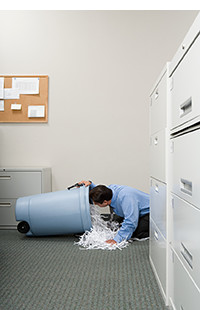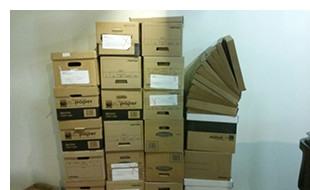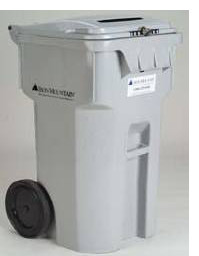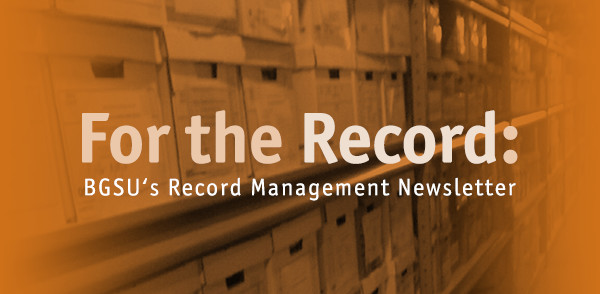|
 Issue FAQ — What is a Certificate of Records Disposal (CRD)?
Issue FAQ — What is a Certificate of Records Disposal (CRD)?Completing a Certificate of Records Disposal when records are destroyed is a small but important part of a records management program. Basically, a CRD documents what records were destroyed when. It’s kind of a death certificate for the records. So why is a CRD needed? Consider what would happen if a public records request is received for records from your office, but you no longer have them because they were destroyed according to your office’s retention schedule. How would you rather respond: that the records in question were destroyed on a specific date, or something along the lines of “we don’t have them anymore” or “they probably were destroyed a couple of years ago according to our schedule”. Those latter two responses, although they may be perfectly true, can appear evasive to a records requestor and call the trustworthiness and reliability of your entire records program into doubt. In addition, by completing a CRD every time records are destroyed, you also develop documentation that records aren’t arbitrarily being destroyed by your office, but that it is done as part of the regular course of business in accordance with a retention schedule. Should a lawsuit or investigation ever arise involving your office’s records, being able to prove that records destructions are performed routinely and according to a schedule can be very important. So do you need to complete a CRD for every piece of paper you throw out? Definitely not. But when destroying record series that are on either the BGSU General Schedule or on your departmental schedule, be sure to complete one. And you should keep the CRD for 10 years after the records are destroyed in case any questions arise. Please also send a copy to me so I can keep track of records destructions as well. You can create your CRD’s online using this form located on the Records Management website. There is also a sample on that page of a completed CRD. As with all things records, if you have any questions about how or when to use a CRD, please contact me at csauer@bgsu.edu or 419-372-9614. Have a question or topic you’d like to see addressed as an Issue FAQ? Please send it to csauer@bgsu.edu. Need Boxes?  Fall 2016 was busy for me as I worked on destroying a couple hundred boxes of records stored in the University Records Center. Usually, the empty boxes from these destructions are recycled because they are too worn out to be used again. However, I currently have about two dozen boxes that, though somewhat dusty, are still strong and sturdy enough to be reused for records coming to the Records Center. They are available on a first come, first serve basis. E-mail me at csauer@bgsu.edu or call 372-9614 to claim some for your office.
Fall 2016 was busy for me as I worked on destroying a couple hundred boxes of records stored in the University Records Center. Usually, the empty boxes from these destructions are recycled because they are too worn out to be used again. However, I currently have about two dozen boxes that, though somewhat dusty, are still strong and sturdy enough to be reused for records coming to the Records Center. They are available on a first come, first serve basis. E-mail me at csauer@bgsu.edu or call 372-9614 to claim some for your office. Iron Mountain Update
Iron Mountain UpdateThis spring marks the second semester of our new arrangement with Iron Mountain, whereby they regularly visit each location that has a shredding bin and swap it out whether full or not. This arrangement was undertaken to be more cost effective in our use of Iron Mountain’s services. Any questions regarding the Iron Mountain schedule, including if you have a one-time request for an extra bin or need your bin(s) swapped more frequently, should be directed to Cory Reinhard in Business Operations at 419-372-7664. She will coordinate any changes to the current schedule. Please do not call Iron Mountain yourself to request a pick-up or other services as this increases our Iron Mountain costs. New Inventory Form Available  Feel overwhelmed by the idea of updating your office’s retention schedule? Well one of the best ways to start is with the new Records Inventory Form now available on the Records Management website. This form, which you can download and fill in multiple times, asks a series of questions about each record series created and used by your office. [A record series is the basic unit for organizing files. It is a group of files kept together physically or intellectually because they relate to the same subject, function, activity or transaction.]
Feel overwhelmed by the idea of updating your office’s retention schedule? Well one of the best ways to start is with the new Records Inventory Form now available on the Records Management website. This form, which you can download and fill in multiple times, asks a series of questions about each record series created and used by your office. [A record series is the basic unit for organizing files. It is a group of files kept together physically or intellectually because they relate to the same subject, function, activity or transaction.]By taking the time to answer those questions, you help me prepare the most appropriate retention schedule for your office. We can also use the inventory form to determine when it might be appropriate to send records to the University Records Center for storage until they pass their destruction dates. Sending records to the Records Center can help free up valuable office space. Finally, identifying what records series your office deals with can help you better manage your electronic records. If you’re due for an updated retention schedule or just want to make sure your current schedule covers all necessary records, give the Records Inventory Form a try!
For the Record is the newsletter of the Bowling Green State University Records Management program. It is distributed electronically to records center users and others responsible for the records of their office. All content is written by Cindy Sauer unless otherwise indicated. To be added to or removed from the distribution list for For the Record please contact Cindy Sauer at csauer@bgsu.edu.
|
|


